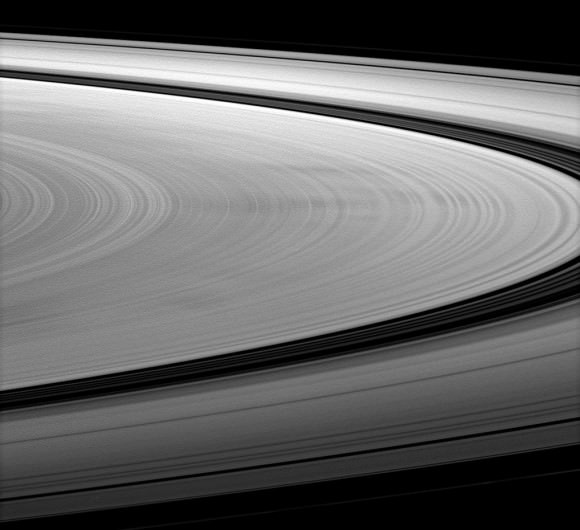As Saturn steadily moves along its 29.7-year-long orbit toward summertime in its northern hemisphere NASA’s Cassini spacecraft is along for the ride, giving astronomers a front-row seat to seasonal changes taking place on the ringed planet.
One of these fluctuations is the anticipated disappearance of the “spokes” found in the rings, a few of which can be seen above in an image captured on Dec. 20 of last year.
First identified by Voyager in 1980, spokes are ghostly streaks of varying size and brightness that stretch radially across Saturn’s ring system. They orbit around the planet with the ring particles and can last for hours before fading away.

One of the most elusive and transient of features found on Saturn, spokes are thought to be made up of larger microscopic particles of ice — each at least a micron or more — although exactly what makes them gather together isn’t yet known.
They are believed to be associated with interactions between ring particles and Saturn’s electromagnetic field.
“The spokes are most prominent at a point in the rings where the ring particles are moving at the same speed as Saturn’s electromagnetic field,” said Brad Wallis, Cassini rings discipline scientist. “That idea and variations of it are still the most prominent theories about the spokes.”
Other researchers have suggested that they may be caused by electron beams issuing outwards along magnetic field lines from lightning storms in Saturn’s atmosphere.
Regardless of how they are created, spokes are more often observed when sunlight is striking the rings edge-on — that is, during the spring and autumn equinoxes. Perhaps the increased solar radiation along Saturn’s equator increases the formation of lightning-generating storms, in turn creating more spokes? It’s only a guess, but Cassini — and astronomers — will be watching to see if these furtive features do in fact fail to appear during Saturn’s northern summer, the height of which arrives in 2016.


From
http://skynotesbyrich.blogspot.com/2010/10/october-17-2010-088-spokes-on-saturns.html
– “As I was reading a Google scan of the February, 1888 – “The Journal of the Liverpool Astronomical Society”, I was surprised when I looked at Plate XII (Figure 14 & 19). It is a drawing by a Society member, Thomas Gwyn Elger, of Saturn’s Rings. What was striking about his drawings was an apparent record of “spokes” on the Rings. If memory serves me, I have read that these ghost like markings were discovered during the Voyager Mission as it scanned Saturn at the end of the 20th. century and more recently by the Cassini Mission. It appears to me that Mr. Elger may have got a jump on us by about a hundred years!” – RICH
Wow, that’s fascinating if so! 92 years before Voyager…
I agree with the statement, “They [rings] are believed to be associated with interactions between ring particles and Saturn’s electromagnetic field.” Understanding this though I think is very difficult.
LC
I think you substitute wrongly. The sentence refer to the “spokes”, those dark sections in the rings. The rings as such are the product of gravity and an icy material, possibly from a broken moon.
Right, my error.
Makes a difference: Dark skies, and good eyes – exceptional optics, and atmospheric conditions of observational night. (Also, a steady hand to sketch the apparition lines.)